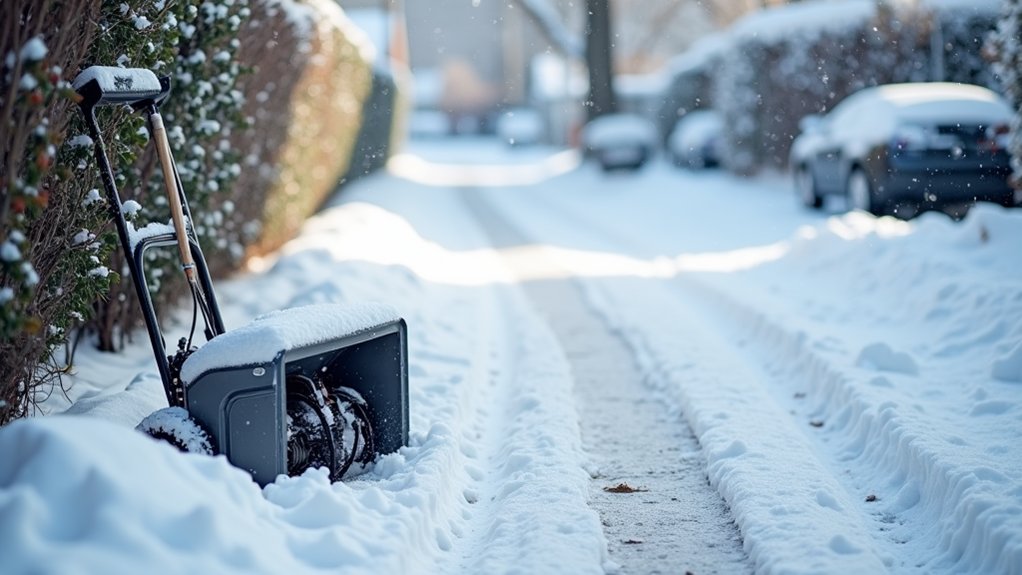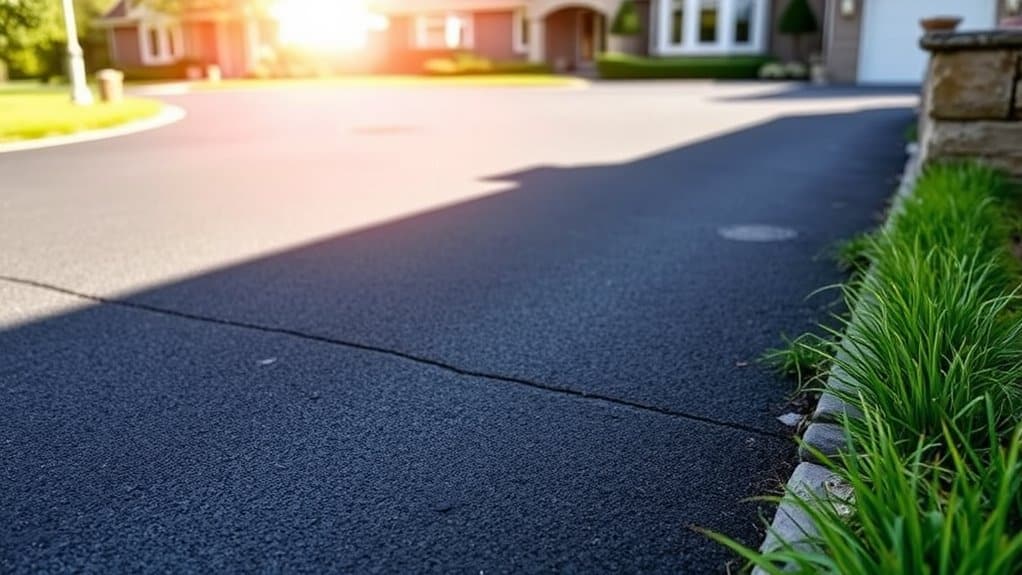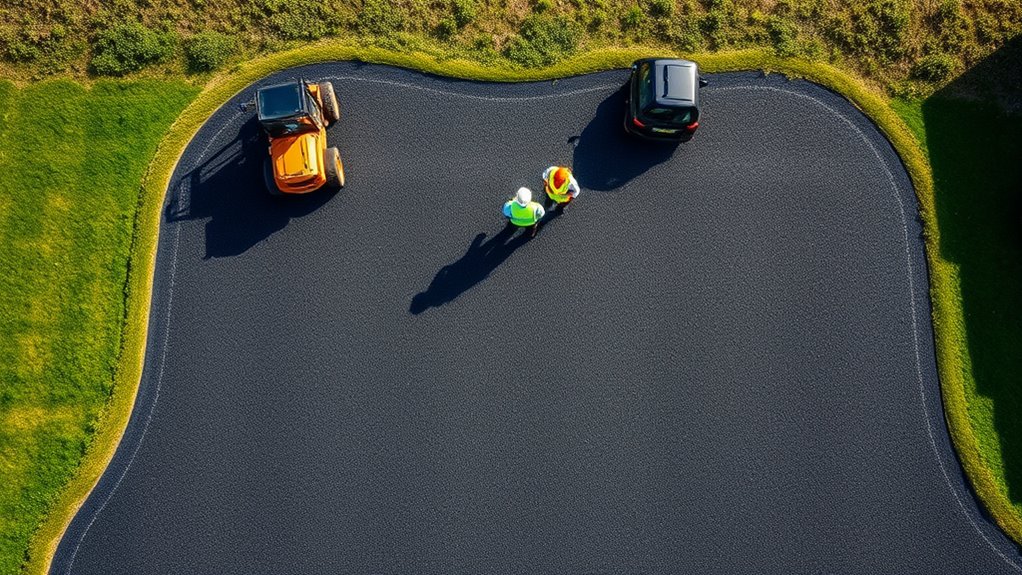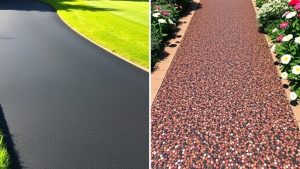To effectively remove snow from your tarmac driveway, use sturdy snow shovels or a snow blower for quick results. Clear snow promptly to prevent it from compacting. Consider pre-treating with salt to create a brine barrier that helps stop ice from bonding. Opt for non-toxic de-icers to protect both your driveway and the environment. Regular maintenance and timely clearing are essential. For more tips and best practices, these insights will help improve your winter maintenance routine.
Table of Contents
ToggleKey Takeaways
- Use wide, sturdy snow shovels to avoid damaging your tarmac driveway during snow removal.
- For larger areas or heavy snowfall, snow blowers are very effective.
- Clear snow promptly to prevent it from compacting and losing the shape of your driveway.
- Apply a pre-treatment of salt before snowfall to create a brine barrier, making snow removal easier.
- Choose eco-friendly de-icers to reduce harm to your driveway and the environment.
Recommended Tools for Snow Removal

When it comes to clearing snow from tarmac driveways, having the right tools is crucial for both efficiency and protecting your surface.
Start with a variety of snow shovels: pusher shovels are ideal for moving light snow without damaging your driveway, whereas standard snow shovels are better suited for heavier falls. Additionally, consider using a snow blower cover to protect your equipment during storage, ensuring it remains in good condition for the next snowfall.
If you’re dealing with medium to heavy snowfall, a snow blower can be a game changer. Both electric and petrol models are available, with three-stage options designed for icy conditions.
For larger areas, truck-mounted snow ploughs or dedicated snow tractors can significantly reduce your workload.
Additionally, roof rakes are handy for removing snow from roofs, and ice picks are useful for breaking up stubborn ice on your driveway.
Choose wisely to ensure effective snow removal this winter.
Chemical De-icers: Pros and Cons
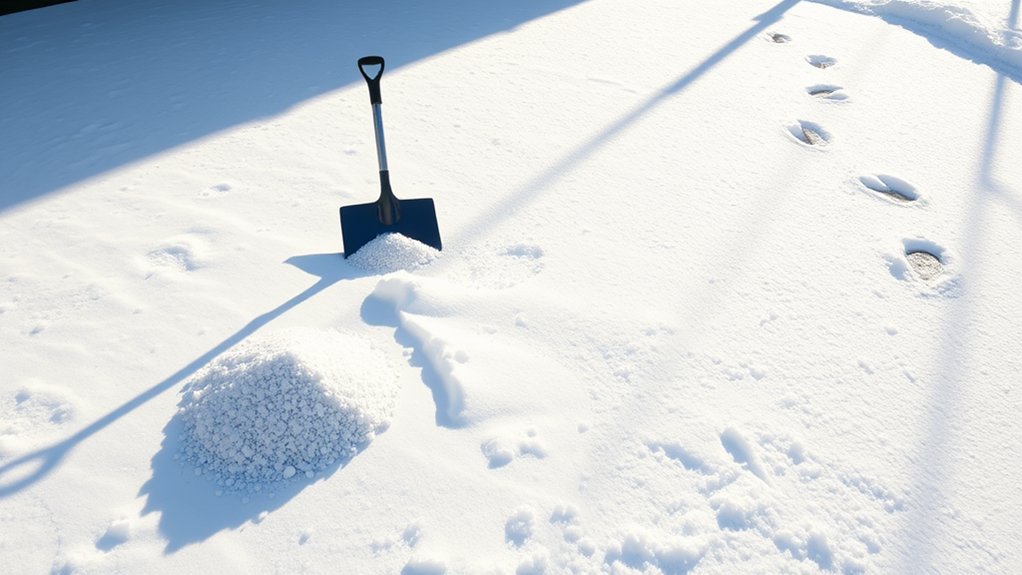
How do you choose the right chemical de-icer for your tarmac driveway? It’s essential to consider both effectiveness and environmental impact.
- Effectiveness: Chemicals like magnesium chloride (MgCl2) and sodium chloride (NaCl) work at different temperatures, so select one that suits your local climate for optimal ice melting. However, be aware that rock salt is the most common de-icer, which means it’s widely available but may require additional chemicals to enhance its melting ability.
- Safety Concerns: Strong chemicals can cause damage to your driveway and pose risks to pets and local wildlife. Look for less corrosive alternatives that are safer for the environment.
- Cost Considerations: Some de-icers may seem cheaper initially, but their long-term environmental effects could lead to hidden costs down the line.
Make an informed choice to protect both your driveway and the environment.
Effective Mechanical Snow Removal Techniques

Clearing snow from your tarmac driveway effectively requires knowing the type of snow and using the right tools.
Start by assessing the snow’s depth and density—this will inform your strategy. For heavy, wet snow, a sturdy snow pusher or plough is best, while light, powdery snow can be easily managed with a snow blower. Understanding snow conditions is crucial when selecting the appropriate tools for your driveway.
A good approach is to use a snow blower first, followed by a shovel for a thorough clean. Consider investing in advanced plough blades, which reduce damage to your driveway and are more cost-effective in the long run.
For steeper areas, fitting your vehicle with tyre chains can improve traction and make snow removal smoother.
Surface Protection Strategies
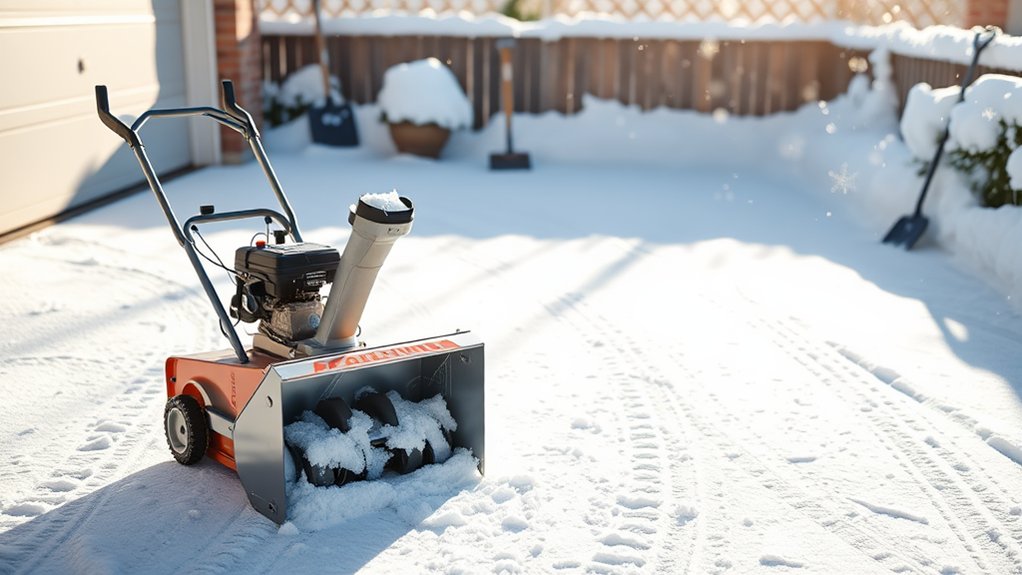
To protect your tarmac driveway, it’s crucial to choose the right tools and materials.
Be cautious with your selection of chemical de-icers, as some can cause more harm than good.
Regular maintenance, such as cleaning and resealing, is vital for prolonging your driveway’s lifespan and keeping it looking its best. Additionally, implementing effective drainage solutions can prevent water pooling and enhance durability.
Consider using a simple broom or pressure washer for cleaning, and a quality sealant to enhance protection.
Tool Material Selection
Choosing the right tool materials for snow removal is essential to protect your tarmac driveway from damage.
Using the right edges can help minimise wear and tear. Here are some effective options:
- Polyurethane Edges: These are ideal for snow removal while keeping your tarmac safe.
- Rubber Edges: A gentle alternative, perfect for careful ploughing.
- Snow Blowers: Suitable for light snow, they won’t scrape the surface.
When selecting tools, steer clear of bare metal edges to avoid damage.
Look for snow shovels or snow casters made from materials that won’t harm your driveway.
Chemical De-icer Choices
Once you’ve got the right tools for clearing snow, the next step is to consider chemical de-icers to protect your tarmac driveway. You have several options to choose from.
Calcium chloride is effective but can corrode metal surfaces. Magnesium chloride is a pet-friendly and eco-friendly alternative that’s safe for asphalt. Calcium Magnesium Acetate (CMA) is biodegradable but tends to be more expensive. Potassium chloride is gentle on surfaces but may not be as effective.
Remember to apply de-icers before snowfall to prevent ice bonding and ensure you use the correct concentration to avoid damage. By choosing eco-friendly options, you’ll help minimise your environmental impact while keeping your driveway safe and accessible.
Maintenance and Care
While snow removal might seem like the main concern for your tarmac driveway, regular maintenance is essential for its durability and performance. Implementing effective surface protection measures can significantly prolong your driveway’s life.
- Carry out seasonal inspections to spot cracks and damage early.
- Clean your driveway regularly to remove dirt and debris.
- Reapply tarmac sealers every 2-4 years, particularly after harsh winters.
Address cracks promptly with tarmac-compatible fillers to prevent water from seeping in and causing further damage. Additionally, it’s crucial to conduct regular inspections to identify potential issues before they escalate.
Always ensure repairs are dry before sealing. By prioritising these maintenance practices, you’ll not only extend the life of your driveway but also create a safer surface during winter.
Timing and Frequency of Snow Removal
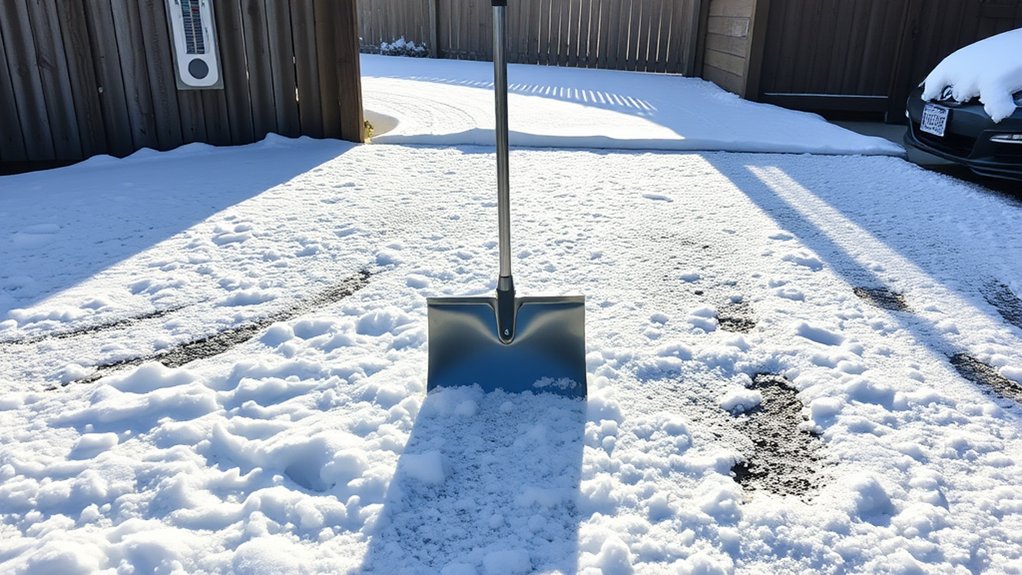
To effectively manage snow on your tarmac driveway, it’s crucial to consider when and how often you remove it.
Aim to clear snow as soon as it falls to avoid it hardening, particularly during persistent snowfall. For instance, if you notice snow accumulating overnight, it’s best to get out early in the morning to clear it.
Regularly checking the conditions will help you keep your driveway in good shape and ensure safe access.
Optimal Removal Timing
When snow builds up on your tarmac driveway, removing it promptly is crucial for both the surface and your safety.
The timing of your snow removal can make a significant difference. Here are the main advantages of clearing snow in the early morning:
- Lighter Snow: Snow that falls overnight is often less compacted in the morning, making it easier to clear away.
- Better Visibility: The morning light helps you see areas that need attention more clearly.
- Reduced Risk: Clearing snow early reduces traffic and helps prevent the snow from being compacted down.
Frequency for Best Results
Regularly assessing and adjusting your snow removal schedule is vital for maintaining your tarmac driveway during winter. The amount and intensity of snowfall will dictate how often you should clear your drive.
Frequent snow removal helps manage build-up and prevents ice formation, reducing the need for chemical de-icers. After heavy snowfall, it’s important to clear large areas quickly and then apply salt for better grip.
Aim to remove snow early in the morning to avoid peak snowfall and get the best results. Regularly check the snow depth to know when to take action.
Additionally, keeping an eye on weather forecasts will help you plan your snow removal effectively, ensuring your driveway stays safe and accessible all winter long.
Environmental Considerations in Snow Removal

With growing concern for environmental issues, it’s important to consider how snow removal methods affect our ecosystem. Traditional de-icers and petrol-powered equipment can lead to soil salinisation, water pollution, and poor air quality. Here are some eco-friendly alternatives to reduce pollution:
- Use electric or manual snow removal tools to cut down on carbon emissions.
- Choose natural de-icers like beetroot juice or calcium magnesium acetate to lessen toxicity.
- Regularly clear driveways after the snow melts to minimise harmful runoff. Implementing eco-friendly practices can make a significant difference for our environment.
These simple changes can make a significant difference for our environment.
Cost-Effective Snow Removal Solutions

Snow removal doesn’t have to be expensive. Here are some cost-effective ways to clear your tarmac driveway without overspending.
Shovelling is a simple and budget-friendly option, with labour costs typically between £20 to £60 per hour, ideal for smaller areas.
If you want to save time, a snow blower can be a good investment, although it comes with initial costs and requires maintenance.
For lighter snow, using a push broom with warm water is quick and inexpensive.
You can also make a DIY de-icer using common household items to effectively deal with stubborn ice.
Advantages of Pre-Treatment With Salt
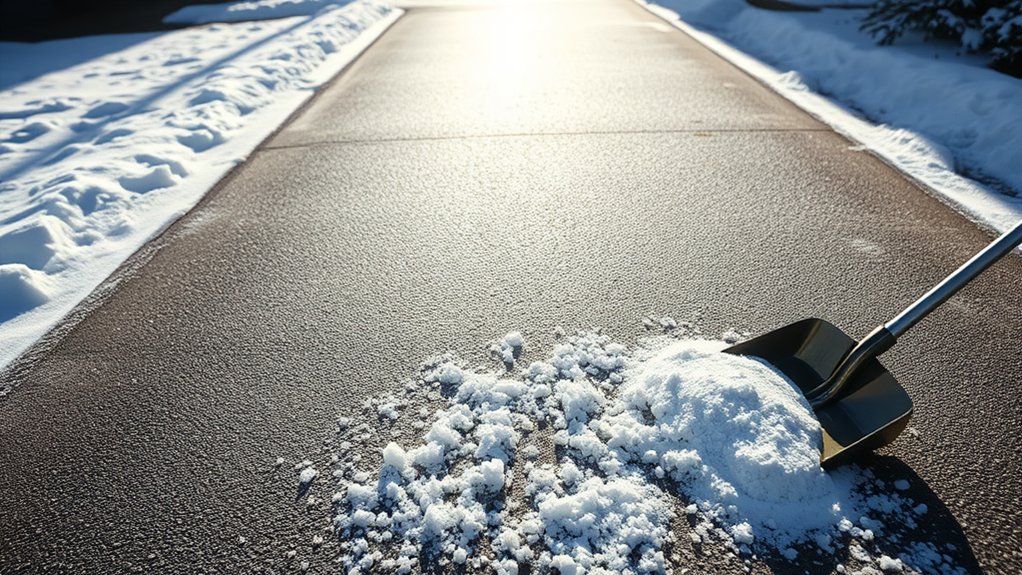
Applying salt before snowfall offers significant benefits for your tarmac driveway, making winter maintenance much easier.
- Prevents Ice Bonding: Salt stops ice from sticking to your driveway, simplifying snow removal.
- Forms a Brine Barrier: This creates a brine solution that slows down ice formation, enhancing snow clearing efficiency.
- Reduces Accidents: A pre-treated surface ensures safer travel for both vehicles and pedestrians.
Using salt in advance not only saves you time but also helps keep everyone safe during harsh winter weather.
Best Practices for Using Snow Blowers
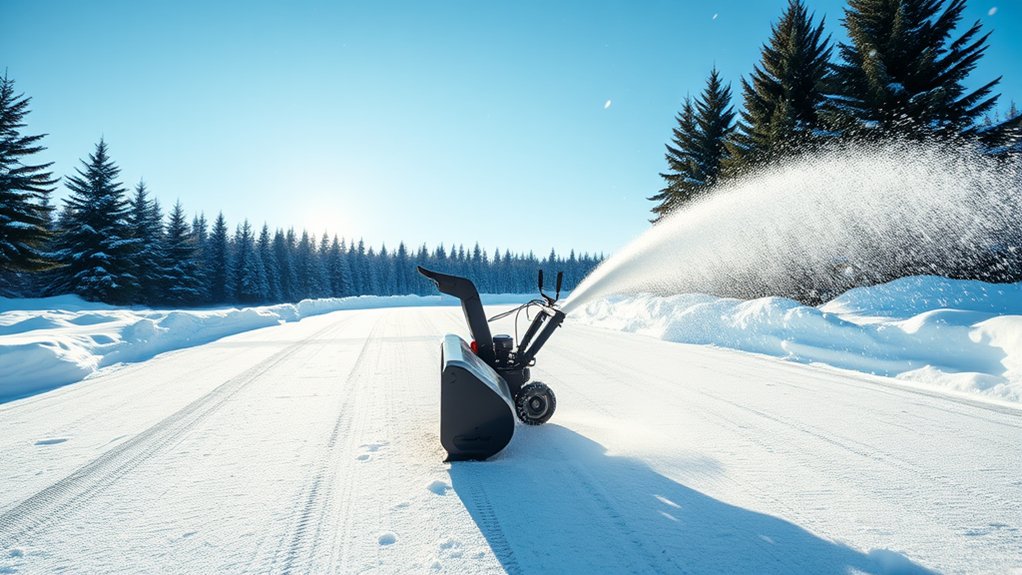
When it comes to efficiently clearing snow from your driveway, knowing the best practices for using a snow blower is essential.
Safety should be your top priority: keep hands and feet away from moving parts and wear protective gear such as gloves and goggles.
Begin from the centre of the driveway and work your way outwards, maintaining a steady pace for even snow removal. Adjust the chute according to the wind direction to avoid blowing snow back onto cleared areas, and overlap each pass for thorough coverage.
Take care around edges and landscaping by using lower settings to protect your driveway. Regularly check your snow blower for blockages to ensure it performs well against different snow types.
Maintaining Your Tarmac Driveway in Winter
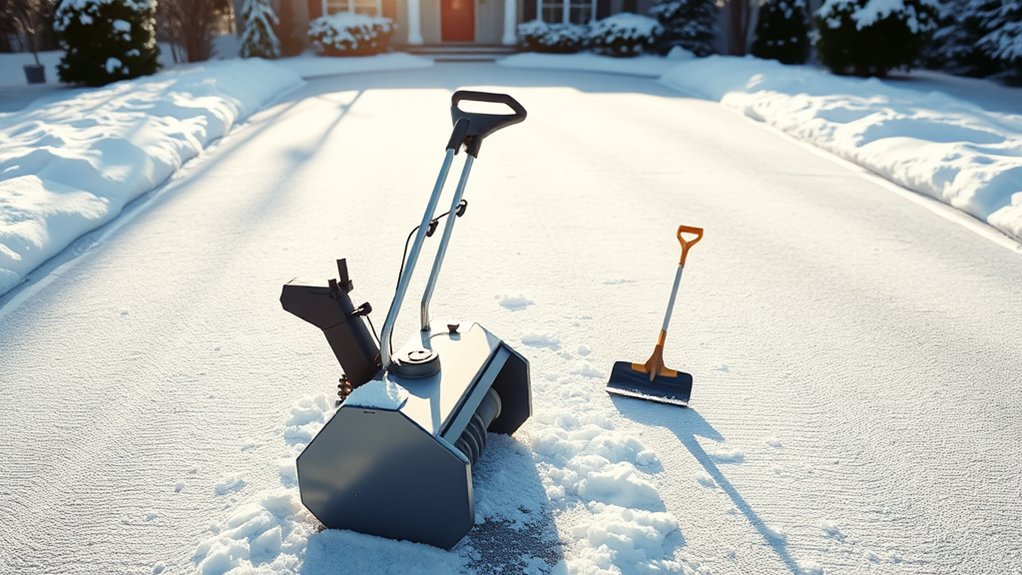
To keep your tarmac driveway in good shape during winter, prioritise effective snow removal and surface protection.
Clear snow promptly to prevent compaction and ice, which can damage the tarmac. Use gentle methods, like a plastic shovel, to protect the surface.
Additionally, sealing the driveway before winter creates a barrier against moisture and freeze-thaw cycles, helping to maintain its durability.
Snow Removal Techniques
Snow removal can be quite challenging, particularly with the specific issues that tarmac driveways face during winter. To ensure effective snow management, consider the following techniques:
- Snow Ploughing: This method is effective for larger areas but requires careful operation to avoid damaging the tarmac.
- Snow Blowers: Ideal for lengthy driveways or heavy snowfall, ensuring quick and efficient snow clearance.
- Shovelling: Best suited for light snow, it helps maintain the surface integrity of the driveway.
To prevent snow compaction and minimise accumulation, clear snow as soon as possible.
Use a wide, sturdy shovel to protect the tarmac from damage. If you choose to use de-icing agents, apply them sparingly to limit any long-term effects.
Regularly check the driveway for any signs of damage and keep an eye on snow depth to ensure a safe and functional surface throughout the winter months.
Surface Protection Strategies
To keep your tarmac driveway in good shape during winter, effective snow removal techniques must be paired with proper surface protection strategies.
Start with sealcoating to protect against water and de-icing salts, which can cause significant damage. Regularly inspect your driveway for cracks and schedule maintenance to keep it in top condition.
Ensure proper drainage to prevent water pooling, and choose non-corrosive de-icers to reduce harm. Address minor issues promptly to stop them from worsening.
Frequently Asked Questions
How Can I Prevent Ice From Forming on My Driveway?
To stop ice forming on your driveway, take some simple steps: ensure proper drainage, pre-treat with anti-icers, and use salt-based products. Regular maintenance during winter will help keep your surfaces clear and safe. For example, clearing any leaves or debris can improve drainage, reducing the risk of ice.
What Should I Do if My Driveway Cracks in Winter?
When winter’s frost causes cracks in your driveway, take action promptly. Focus on maintaining your driveway by sealing small cracks and arranging repairs as needed. Regular inspections can help prevent further damage, ensuring your driveway remains resilient against harsh winter conditions. For example, if you spot a small crack, use a suitable sealant to prevent water from seeping in and freezing, which could expand the crack.
Are There Eco-Friendly Alternatives to Traditional Salt?
Consider using eco-friendly options like vinegar as a natural substitute for traditional salt. Furthermore, materials such as sand or small stones can offer traction without causing environmental harm, making them sustainable choices for managing snow effectively.
Can I Use a Metal Shovel if I’m Careful?
“Better safe than sorry.” You can use a metal shovel if you’re cautious, but it may damage the tarmac. It’s wiser to choose a plastic or rubber shovel to keep your driveway safe and sound.
When Is the Best Time to Apply De-Icer?
The best time to apply de-icer is when temperatures rise above freezing. Keep an eye on the weather, as using de-icer during warmer spells boosts its effectiveness and helps prevent re-freezing. This approach ensures better results while protecting your tarmac surface.
Conclusion
In summary, selecting the best snow removal method for your tarmac driveway involves considering the right tools and techniques. Combining effective mechanical methods with chemical de-icers and protective measures can help ensure safety while preserving the surface. Regular maintenance and prompt snow removal can save you both time and money, keeping your driveway accessible and in good shape throughout winter.
Just how long can you expect your tarmac driveway to last? Discover key factors and maintenance tips that can extend Read more
From planning to final touches, discover the essential steps of tarmac driveway installation—what could go wrong if you skip any Read more
Wondering if a tarmac driveway is the perfect fit for your home? Uncover the essential pros and cons before making Read more

